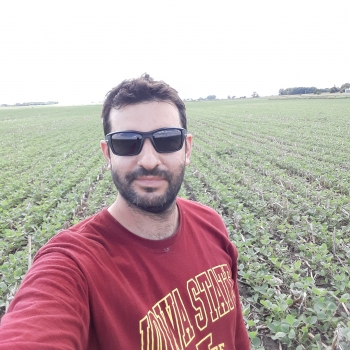
Agronomy graduate student Luis Bentancor, along with associate professor Dr. Bradley Miller, has been awarded $14,964 in grant money to study soil health indicators in areas impacted by the Dakota Access pipeline installation.
The North Central Region of Sustainable Agriculture Research and Education (NCR-SARE) awarded the funds as part of their Graduate Student Sustainable Agriculture Grant Awards.
Bentancor said they spent about a month to get the proposal for the grant ready and it took about three months to hear they had been awarded the funds.
He said this project came about because of concerns raised by farmers who have observed lower crop yields on the Right of Way (ROW) since the installation of the Dakota Access Pipeline (DAPL) in 2016. This creates a unique opportunity to study soil health, resiliency and resistance across a spectrum of soil parent materials, landscape positions and management practices.
“We have designed a questionnaire for farmers located in the Right of Way to survey their interests to participate in this project, where we ask questions about the conditions when the pipeline was installed, application of any special treatment after pipeline installation, willingness to be with us in the field during sampling among others,” Bentancor said. “We are going to assess physical, chemical and biological properties to evaluate the different soil health indicators in two different physiographic regions, Des Moines Lobe and Southern Iowa Drift Plain.”
“We are going to select fields in central and southeast Iowa, to capture a range of soils in Iowa. We will have different soil materials, different hillslope conditions and management practices,” Bentancor said. “So, we will have a variety of conditions to assess how the soil health evolved after six years following the pipeline installation.”
A large amount of the grant money will be used to conduct lab analysis on the soil and for undergraduate training on different lab procedures in the process. Bentancor will collect the soil samples, perform many of the lab measurements, and analyze the final results.
“Our hypothesis is that the capacity of soil health indicators to recover to their original condition will vary by parent material, landscape positions, and management practices,” Bentancor said. “The goal is to create a unique dataset of soil health indicators across a range of soil-forming conditions to better understand soil resiliency and the factors that support the regeneration of healthy soil.”
To accomplish this, samples will be taken along the DAPL path implementing a sampling design stratified by parent material, landscape positions, management practices and disturbed versus undisturbed areas. The Pipeline ROW will then be divided into three parts: pile area, trench area and traffic area.
Relationships between measured soil properties and patterns in remote sensing data will be detected using machine learning. “With this additional step we are seeking to produce a spatially predictive model capable of mapping the soil’s health indicators measured within and surrounding the pipeline ROW,” Bentancor said.
They expect to finish the fieldwork by the end of fall 2022 if the weather cooperates, with the data analysis and lab work to be done by October 2023.





